Updated 12 Sep 2013
|
Notable Trees in BH18
|
|
A notable tree is remarkable or distinguishable in some way,
or related to a famous or historical person, place or event.
Here are some notable trees in the the BH18 (Broadstone, Dorset)
postcode area. If you have information
about notable trees not listed here, please
contact me on:
Convert lat/long & OS | Calculate age of oaks
|
1. Oak
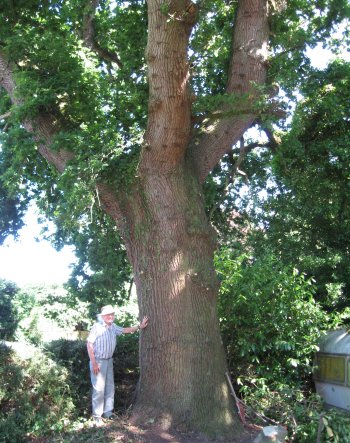
4.27m
1767 |
2. Monterey
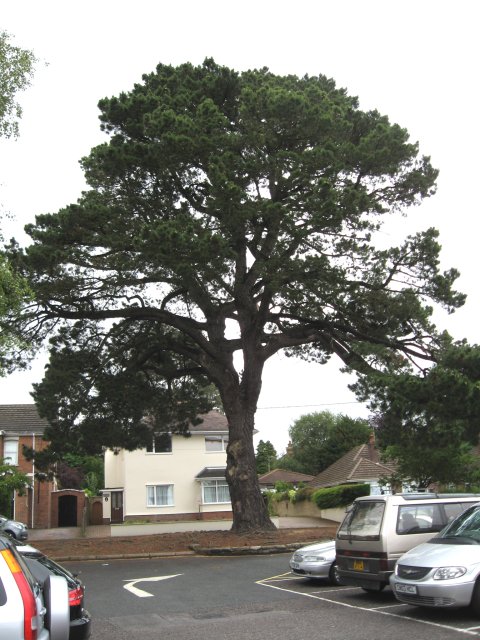
4.27m |
3. Chile
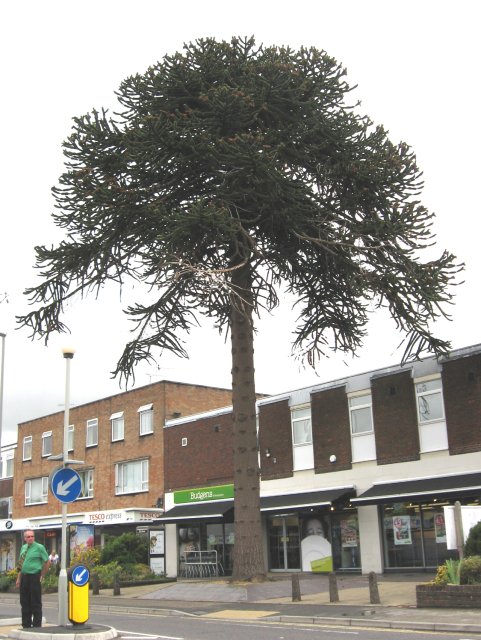
2.50m
1897 |
4. Sequoia
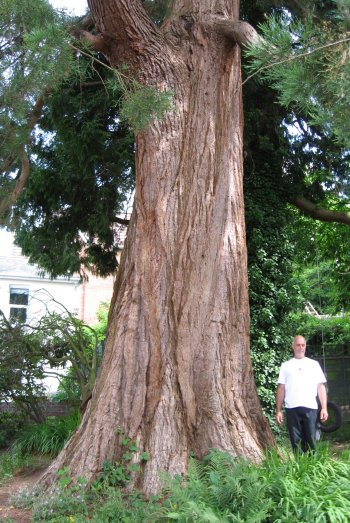
5.60m |
5. Oak
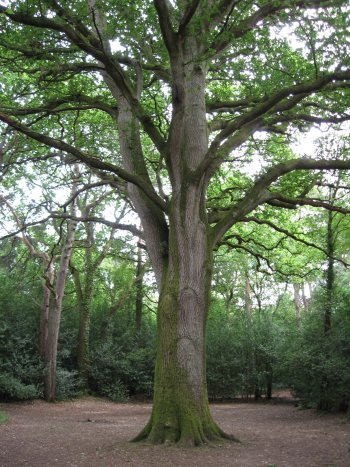
4.70m
1729 |
6. Oak
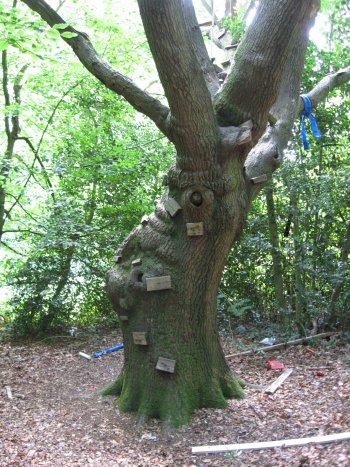
2.90m |
7. Chestnut
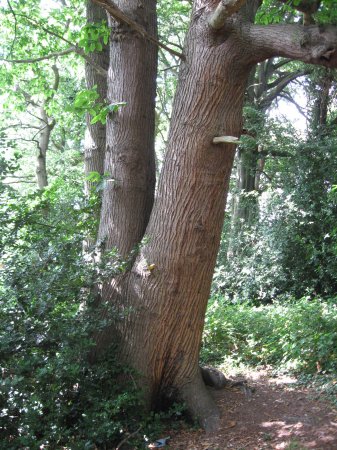
4.70m
1792 |
8. Oak
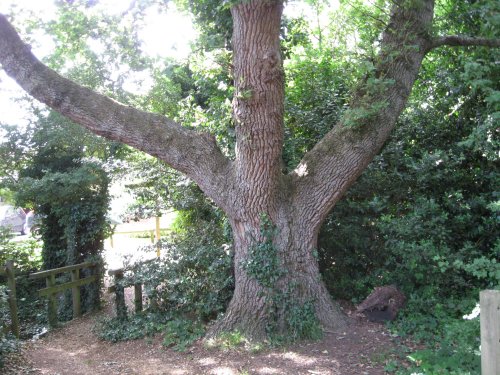
3.97m
1796 |
9. Fossil
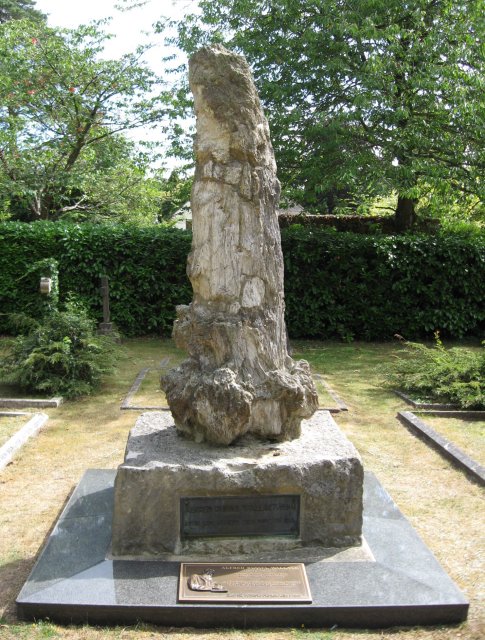
1.75m
146 My |
10. Monterey
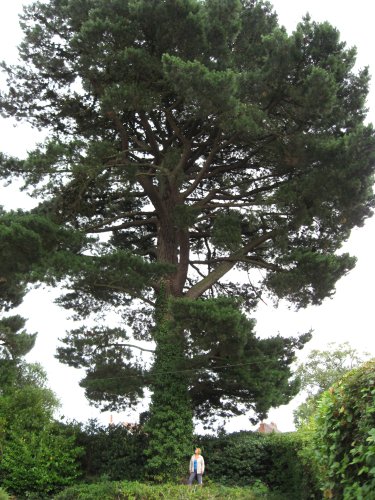
4.00m |
11. Oak
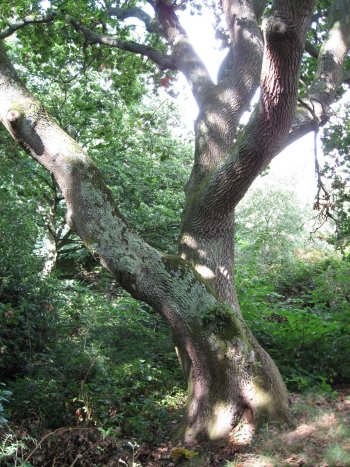
4.40m
1758 |
BH-2396.
Oak at #5
 |
Oak at 5, Higher Blandford Road
Quercus robur
Location: 50.763415, -1.997767; SZ-00254-95981
Front garden of 5 Higher Blandford Road.
Girth=4.27 metres.
Estimated Age: 243 years. Planting year: 1767.
(Calculation
based on Environment classification of
"C. Average site, garden, park land")
Covered by area T.P.O: #9 registered 7 June 1955.
See:
Ancient-tree-hunt database
and
Geograph database
Owner resident since 1946, when a brook ran between tree and South hedge,
(now piped below ground).
The brook may have helped swell its size.
Tree recently cleared of ivy.
The oak has a girth 4.27 metres .
Easy to see from the pavement.
The council have erected a streetlight, which disappears
into the branches. They may have to choose between moving the
streetlight or the branches.
I have registered the oak on the Woodland Trust Ancient-Tree-Hunt website,
the first in Broadstone,
|
|
BH-2373.
Monterey Pine
 |
Monterey Pine at Central Carpark, Broadstone
Pinus radiata
Location: 50.760182,-1.992928; SZ-00595-95621.
In Kirkway next to Hadleigh House.
Girth=4.27 metres.
Not covered by any known T.P.O.
See:
Ancient-tree-hunt database
and
Geograph database
Probably planted in 19th Century in back garden of Burton House, since
knocked down and replaced by shops and carpark.
This tree was cut down on 12 Sep 2013 for safety reasons.
The author photographed the rings 1 metre above ground level.
The photo was enlarged, and 118 rings counted,
indicating the tree was planted about 1895.
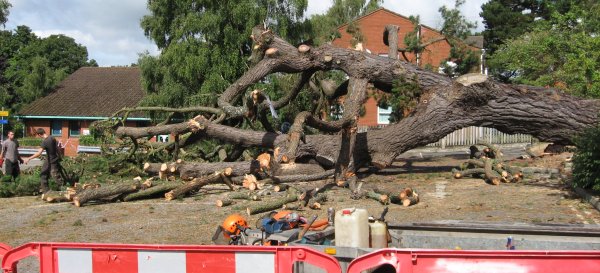
|
|
|
BH-2375.
Monkey Puzzle
 |
Monkey Puzzle in Broadway, Broadstone
Araucaria Araucana; Chilean Pine; National Tree of Chile.
Location: 50.759521,-1.993736; SZ-00538-95547.
On Broadway next to Stepping Stones.
Girth=2.50 metres.
Estimated Age: 113 years. Planting year: 1897.
(Calculation
based on Environment classification of
"C. Average site, garden, park land")
Covered by TPO 5/2000.
See:
Ancient-tree-hunt database
and
Geograph database
Probably planted in 19th Century in front garden of Burton House, since
knocked down and replaced by shops and carpark. This tree is the landmark
for the Broadway, Broadstone's main shopping centre, when climbing the
long, steep hill from Poole. It should be placed on Broadstone's crest.
The male and female cones are on different trees, which Gender is this?
Before the trees regular "trim"
to give it a more pleasing
appearance. The council do a good job. |
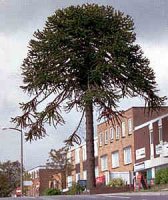 |
|
 |
A local firm has a logo with the Broadstone Monkey Puzzle tree.
However the text Araucaria Imbricata is invalid, the species name
should be Araucaria Araucana, see
Wikipedia
|
|
|
|
BH-2381
Giant Sequoia
 |
Giant Sequoia at Home Cottage, 73 Higher Blandford Rd
Sequoiadendron giganteum, incorrectly called Wellingtonia
Location: 50.767251, -2.000361; SZ-0007-9640.
Garden of 73 Higher Blandford Rd.
Girth=5.60 metres @ 2 metres.
Covered by Area T.P.O #9 registered 7 June 1955.
See:
Ancient-tree-hunt database
and
Geograph database
Growing in the garden of Home Cottage, it may have been planted by
Miss Cotton (ref nearby Cotton Close). The species was introduced
into the UK after 1853 from California.
(Growth in Britain is very fast, with the tallest tree, at Benmore in
southwest Scotland, reaching 54 m (177 ft) at age 150 years, and several
others from 50-53 m tall; the stoutest is around 12 m in girth and 4 m
in diameter, in Perthshire)-Wikipedia
The top from a distance
|
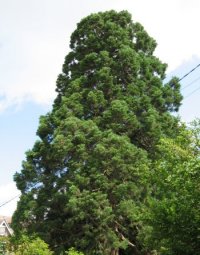 |
|
|
BH-2386
Oak in Delph Woods
 |
Oak in Delph Woods
Quercus robur
Location: 50.773026; -1.983985; SZ-01226-97049.
In Delph Woods.
Girth=4.70 metres @ 1.5 metres.
Estimated Age: 281 years. Planting year: 1729.
(Calculation
based on Environment classification of
"C. Average site, garden, parkland")
Not covered by any known T.P.O.
See:
Ancient-tree-hunt database
and
Geograph database
A fine symmetrical tree, in the centre of a circular clearing,
about 150 metres
South of the end car park on the access track to Delph Woods. The canopy
(larger than most at 31m x 23m) stands out clearly on Google Earth,
and allows an accurate location. The girth indicates an age of 400 years,
and the canopy symmetry may mean a very old clearing too.
However,
another view states: "you can't miss the magnificent 200 year
old common Oak standing 80 feet high with a circumference of just over
13 feet, the foliage in the summer is so dense that nothing grows under it"
The canopy is 31m x 23m, larger than nearby trees |
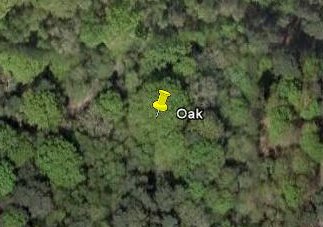 |
|
|
BH-2392
Tree House in the Clump
 |
Tree House in the Clump
Quercus robur
Location: 50.757809, -2.005546; SY-99705-95357.
Rear Garden of 51 Upton Way
Girth=2.90 metres @ 1.0 metre.
Not covered by any known T.P.O.
A good size oak, maybe in the back garden of 51 Upton Way,
large tree house built in the branches, falling to bits,
maybe the children have grown up?
The tree house in the branches |
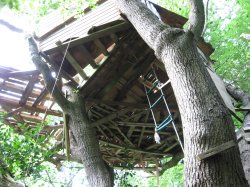 |
|
|
BH-2398
Sweet Chestnut in Hillbourne Copse
 |
Sweet Chestnut in Hillbourne Copse
Castanea sativa
Location: 50.753204, -1.996008; SZ-00378-94845.
Edge of Hillbourne Copse.
Girth=4.70 metres @ 1.0 metre.
Estimated Age: 218 years. Planting year: 1792.
(Calculation
based on Environment classification of
"C. Average site, garden, park land")
Covered by TPO 39/2000.
This may be
two trees that have grown together, but more likely to be
two stems grown from one root, as often happens. Right on the
(wrigly) border of BH18.
|
|
BH-2401
Oak in Pocket Park
 |
Oak in Pocket Park
Quercus robur
Location: 50.754061, -1.992832; SZ-00602-94940.
Edge of Pocket Park.
Girth=3.97 metres @ 1.5 metre.
Estimated Age: 214 years. Planting year: 1796.
(Calculation
based on Environment classification of
"C. Average site, garden, park land")
Not covered by any known T.P.O.
A big oak that has lost its leader early in life, the 4 main branches
taking over its role. The brook under the footbridge may have helped
swell its size. Located a few yards inside the BH18 boundary, in a
line of slightly lesser oaks.
|
|
BH-2402
Fossil tree on Wallace's grave
 |
Broadstone's oldest tree
Protocupressinoxylon purbeckensis Francis
Location: 50.765029, -1.982194; SZ-01352-96160.
Cemetery off Dunyeats Rd.
Girth=1.75 metres @ 1.5 metre. Age approximately 146 million years
See:
Geograph database
An unusual grave in Broadstone Cemetery, restored by the
A. R. Wallace Memorial Fund in 2000.
It features a 7-foot (2.1 m) tall fossil tree trunk from Portland
mounted on a block of Purbeck limestone.
Alfred Russel Wallace, OM, FRS (8 January 1823 – 7 November 1913)
was a British naturalist, explorer, geographer, anthropologist and
biologist. He is best known for independently proposing a theory of
evolution of species by natural selection that prompted Charles Darwin to
publish his own theory jointly with Wallace in 1858. Wallace lived in
Old Orchard, a house he designed himself (1901), built in 1902, knocked down ,
in 1964, which stood where Wallace Road now stands.
The age of the tree is late Jurassic, about 150 million years old.
The grave is located 50 metres beyond the main gate, on the right,
very obvious.
"Dr Paul Kenrick of The Natural History Museum, London, examined a small
fragment of the fossil wood from the grave monument using a scanning
electron microscope and found that the wood has tracheids with closely
spaced pits, similar to those known from
Protocupressinoxylon purbeckensis Francis, an approximately
146 million years old conifer of the subfamily Cheirolepidiaceae,
found in the Lower Purbeck Formation (Lower Dirt Bed or Great Dirt Bed)
in the Portland/Swanage area of Dorset."
"It is known that Wallace accompanied the American Palaeontologist
Lester F. Ward on a field trip to the Isle of Portland in 1894 to collect
fossil wood (see Ward, 1896) and one of the species collected on this
trip was even named Araucarioxylon wallacei Knowlton after him.
Interestingly, several pieces of fossil wood were found in the garden of
Old Orchard after Wallace died by the Tyndale-Biscoe family, who rented
the house from Wallace's son in 1916 (the late Mrs Barbara Waterman nee
Tyndale-Biscoe pers. comm.). These fragments, although smaller, were very
similar in appearance to the fossil on Wallace's grave, so it is possible
that the trunk on the grave was collected by Wallace and that it was taken
from Old Orchard following his death."
From: Fossil tree on
Alfred Russell Wallace website.
|
|
|
|
BH-2422
Monterey Pine on Lancaster Drive
 |
Monterey Pine
Pinus radiata
Location: 50.765306, -2.004202; SY-99800-96191.
Front Garden of 2 Lancaster Drive.
Girth=4.00 metres @ 1.5 metre.
See:
Ancient-tree-hunt database
Covered by area T.P.O: #9 registered 7 June 1955.
A fine tree (1) in the front garden of 2 Lancaster Drive.
This Pine is part of an Area Tree Preservation Order
ID #9 Registered 13 Sep 1955, about when the bungalow
was built. A similar tree (2) is in the back garden, and a third
Monterey Pine was in between but fell some years ago.
These trees and several more to the East (#6 has
a girth of 4.5 metres) once marked a right of way between
Lancaster Drive (LD) and Higher Blandford Road (HBR) across fields.
These pines (1-6) seem to point at the Giant Sequoia (S)
in a bend of the Zigzag (ZZ)
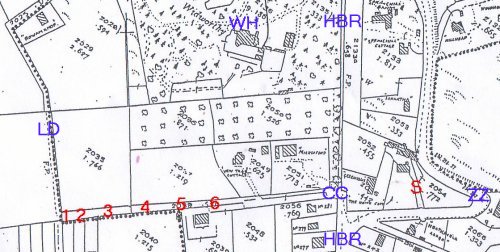
The right of way which appears on this TPO map of 1955 once formed a boundary
to land around Widworthy House (WH), owned by Lionel Cotton, a local solicitor.
The big house has now been replaced by 3 small modern houses, but the foundation
wall is still visible, and the right of way is now part of Cotton Close (CC)
The line of pines is now where back gardens of bungalows meet.
It is said that Miss Cotton (dau of Lionel) used
to walk the right of way regularly to keep it open.
|
|
|
BH-2428
Oak at Pinesprings
 |
English oak
Quercus robur
Location: 50.751944, -2.011657; SY-99274-94705
on Pinesprings Place Local Nature Reserve.
Girth @ 0.5m = 4.40m.
Estimated Age: 252 years. Planting year: 1758.
(Calculation
based on Environment classification of
"C. Average site, garden, park land")
See:
Ancient-tree-hunt database
T.P.O: unknown.
A large tree in Pinesprings Place Local Nature Reserve, on the wooded
western edge of a grassy triangle, easily reached by the public footpath
from Pinesprings Drive.
The low fork appears to be totally natural, and the tree-form to be maiden
rather than multi-stem.
The girth was measured at only 0.5 metres, so the calculated age is
probably too old.
From an article by Dr.P.Mathers
in Broadstone Residents Assoc. Magazine, summer 2010
"Situated in a small piece of deciduous woodland on Pinesprings
Place Local Nature Reserve. The following notes describe its
role as a keystone species in the ecology of the nature reserve.
The oak tree was leaning on a slope and hence covered a greater
area than if it had been upright. It was linked to the wildlife
of the other habitats of the Reserve, (meadow, scrub, wet heath),
both in terms of the structure and Ecology of the Reserve.
During the years of 2005 to 2006 the Jay and the Great Spotted
Woodpecker used the structure of the tree as nesting sites. In
terms of ecology, during the same period, the oak trees on the Reserve
had a more intimate relationship with the 67 species listed in the Table.
In theory, the oak tree is host to 284 species of insects in Britain
(Southwood 1961) so the figure of 27 insect species on this reserve
represents 10% of the possible number that could be present."
|
Family |
Species |
Family |
Species |
Flora |
Lichens |
10 |
Fungi |
6 |
Fauna |
Flies |
3 |
Bees/wasps |
14 |
Beetles |
4 |
Spiders |
5 |
Bugs |
2 |
Harvestmen |
1 |
Lacewings |
2 |
Birds |
17 |
Sawflies |
2 |
Mammals |
1 |
|
|
|
|
Estimating the Age of Trees |
by  |
The Forestry Commission have produced an 'Information Note'
enabling the age of trees to be estimated.
SUMMARY
A method of age estimation is proposed that avoids
damage to vulnerable specimen trees. It relies upon
comparison with lists of measurements of known date.
From these the likely performance of various species
in different locations on particular site types can
be evaluated. Cross-referencing between individual
specimens is credible because trees develop predictably
through well-defined patterns of growth. Age can be
calculated largely from annual ring areas within the
stem, as determined by a simple girth measurement.
Reference:
"Estimating the Age of Large and Veteran Trees in Britain" by John White
Forestry Commission Information Note, Nov 1998
|
The general idea is that the amount of wood laid down is
proportional to the number of leaves. The size of the canopy
increases until after 40-100 years, optimum crown size is
reached and the amount of wood laid down stabilises. Their
method can be boiled down to some simple arithmetic with a
calculator. Readers should have a go.
FORMULAE
e=G2/4π
c=π(YR)2
a=e-c
d=πR(Y-1)2
b=c-d
AGE=Y + (a/b)
|
G is the girth of the tree, measured in cms at chest height.
Y (core age in years) and R (core ring width in cms) are from
Forestry Commission databases for 20 species and 6 environment
categories (A-F). Here are the numbers:
Y R Common oak, various Environments
70 0.50 A. Champion tree potential (ideal site conditions)
80 0.40 B. Good site, open grown, sheltered.
100 0.35 C. Average site, garden, parkland.
120 0.30 D. Poor ground and/or some exposure.
100 0.35 E. Woodland boundary pollard, or open woodland.
70 0.25 F. Inside woodland.
Various species, Average Environment
Species Y R Species Y R Species Y R
Sweet chestnut 60 0.50 Beech 70 0.40 Common oak 100 0.35
Black Mulberry 30 0.30 Walnut 50 0.40 Turkey oak 50 0.50
Horse chestnut 40 0.50 Ash 70 0.40 Common Lime 70 0.50
Cedrus deodara 50 0.60 Plane 70 0.50 Chile Pine 60 0.40
Pinus Nigra 70 0.50 Red oak 80 0.40 Sycamore 60 0.60
|
|
B=Good site, open grown, sheltered |
C=Average site, garden, parkland |
D=Poor ground, some exposure
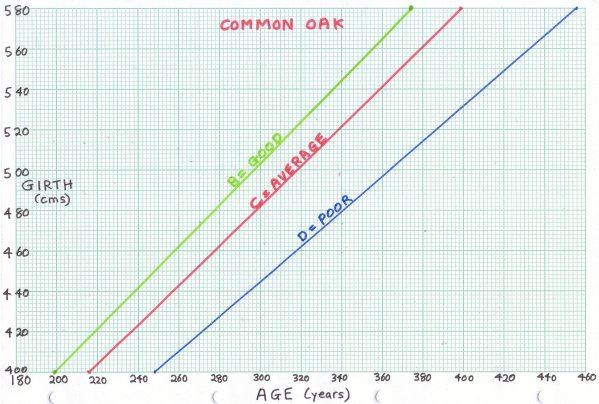
|
So what are the results like? I did the calculations for a
fine big healthy oak growing in a friend's garden.
When it came to deciding what the environment was, I did the
calculation for all environments and compared the results. Here
they are.
Girth=427
A. 167 years
B. 221
C. 239
D. 274
E. 239
F. 566
|
Well, its obvious that my estimate of the tree's environment
throughout it's life was all important! Ignoring the extreme cases,
the average was 243 years, indicating "Average site, garden, parkland."
In fact the tree was in someone's garden, next to a brook
(now carried by a pipe) which gave the village its name. Even so,
I feel I need an evening course in judging tree growing environments!
Can Rachel and the Trees4Dorset arrange that I wonder? |
The method is not as accurate as I had hoped, but it does no damage
to the tree, is easy to measure and calculate. I suppose the result
can't be contradicted without killing the tree, drilling holes or
using some kind of acoustic radar to count rings.
|
|
Compiled, formatted, hyperlinked, encoded,
and copyright © 2010, John Palmer,  All Rights Reserved. All Rights Reserved.
|